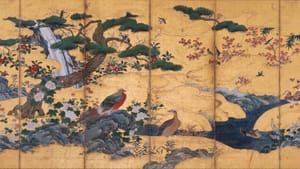Stay in the Loop
BSR publishes on a weekly schedule, with an email newsletter every Wednesday and Thursday morning. There’s no paywall, and subscribing is always free.
Family reunion, once in a millennium
Art of the Kano at the Art Museum

In America, three generations of Wyeths constitute an artistic dynasty. Contrast that with Japan, where the Kano family dominated painting for 16 generations.
The family’s artistic dominance stretched from the Muromachi period in the 15th century until the end of the Meiji period in the 20th, during which Japan evolved from an isolated feudal society to a more modern form.
The Kano lineage was established by Kano Masanobu (1434-1530), who received commissions to create large-scale screens and sliding doors for royal residences, palaces, and Zen temples. Succeeding Kano generations also were hired to design the homes and teahouses of wealthy merchants. After a change in Japanese dynasties in 1912, royal patronage ceased and Kano family members turned to other pursuits, such as tea farming.
With the cooperation of the Agency for Cultural Affairs of Japan and the Tokyo National Museum, the Philadelphia Museum has assembled more than 120 works, the largest concentration of Kano art ever. It’s a treat for art lovers and especially for me, since I recently toured the show in the company of Nadine Kano, the 20th generation of this illustrious family, who grew up in the U.S. and like everyone else in America was seeing most of this work for the first time. (Four-fifths of these treasures were in private hands and had never before left Japan.) Nadine said she grew up hearing about the long-ago exploits of her ancestors (such as the legend that she was descended from a general who fought off Mongol invaders). But her great-great grandfather, Kano Tomonobu, was the last of the lineage to practice art as a vocation.
Wise old trees
Working in ink and creating colors from vegetables and minerals on silk or paper, the Kanos depicted landscapes, flowers, birds, trees, and mythological stories of dragons and phoenixes. The oldest painting, near the entrance, predates Columbus’s first voyage to America. As the centuries passed, they began drawing on gold leaf and expanded their subject matter to the sea and Mount Fuji. The most prominent images are stark, solid, and formidable rocks, as well as trees that seem old and wise as they twist and envelop the things around them. The Kanos especially favored pine trees for their longevity and stability.
“It’s overwhelming,” Nadine told me as we walked among the collection. “It’s like visiting my family. Actually, it’s like attending a reunion where you meet some family members you never met before.”
She and I agreed on our favorite creation: a large six-panel folding screen with dozens of silk fans pasted on its surface, each fan individually painted in a different style. Nadine also loved an ink of a majestic dragon floating among the clouds.
Side benefit
The Art Museum will coordinate this show with lectures, films, family events, and “Art After 5” gatherings, as well as a 350-page book published by the Museum in association with Yale University Press.
Because the art on display is so fragile and light-sensitive, the level of lighting is kept low, and the works will be rotated twice over the course of three months. A side benefit of this arrangement, of course, is that you can return a second and third time and see completely new collections.
What, When, Where
Ink and Gold: Art of the Kano. Curated by Felice Fischer and Kyoko Kinoshita. Through May 10, 2015 at Dorrance Special Exhibition Galleries, Philadelphia Museum of Art, 2600 Benjamin Franklin Pkwy. 215-763-8100 or www.philamuseum.org.
Sign up for our newsletter
All of the week's new articles, all in one place. Sign up for the free weekly BSR newsletters, and don't miss a conversation.
 Steve Cohen
Steve Cohen